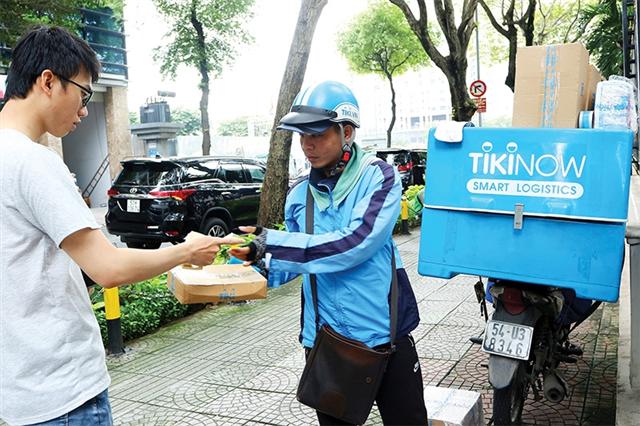Vietnam keen on encouraging ASEAN e-commerce solutions
Vietnam keen on encouraging ASEAN e-commerce solutions
In light of a boom in e-commerce across Southeast Asia, Vietnam as the ASEAN chair in 2020 is determined to encourage the growth of cross-border e-commerce across the region.

Tiki is one of Vietnam’s up-and-coming e-commerce services that also wants to extend towards other regional countries, Photo Le Toan
|
In its role as the ASEAN chair this year, Vietnam launched the official ASEAN Online Sale Day to stimulate cross-border e-commerce in the region.
The event, held on August 8, saw participation of 216 companies across all 10 member states. Along with strengthening intra-bloc solidarity, the event assisted regional economic recovery amid the pandemic, while digital consumers in the ASEAN experienced cross-border e-commerce in an open, safe, and quality manner under the supervision of governments. Companies also promoted their platforms and services to regional customers.
Richard Burrage, CEO of market research company Cimigo, told VIR that Vietnam has a great role to play in stimulating the Southeast Asian online shopping market. “A strong digital, entrepreneurial, technologically-savvy consumer base in Vietnam supports the demand side and is leading the region in building new tools and ecosystems to support online sales growth,” he said.
As a result, local e-commerce platform Tiki experienced growth of more than 50 per cent in sales during ASEAN Online Sale Day. Ngo Hoang Gia Khanh, group vice president of growth at Tiki, told VIR that although the company has been focusing on the Vietnamese market, it aspires to promote e-commerce also across the region.
In order to respond to ASEAN Online Sale Day as well as support customers during the pandemic, since early August Tiki has launched a variety of promotions and services, such as thousands of discount coupons, free shipping, same-day delivery service, and more.
“Besides our own programme, we also promoted the ASEAN Online Sale Day with banners and announcements on our social media and onsite platforms to leverage the programme coverage and reach as many consumers as possible,” Khanh said.
The promised land
By the end of 2020, the number of digital consumers in Southeast Asia could reach 310 million, a number previously forecast to be reached only by 2025. This means almost 70 per cent of Southeast Asian consumers will go digital by the end of 2020.
Southeast Asia’s online retail market penetration has now also surpassed India’s, increasing as much as 1.6 times to reach 5 per cent, according to the latest annual report by Facebook and Bain & Co.
The report said that 2020 has been a pivotal year. Social distancing has paved the way for home-centric lifestyles as well as commerce with minimal physical contact. This disruption has inadvertently accelerated the growth of Southeast Asia’s digital economy.
Thus, there are many opportunities for Southeast Asian companies to ride the cross-border e-commerce wave, Burrage from Cimigo noted. In particular, the potential for improved lower-cost logistics for sourcing goods across borders will make the size of the prize worthy of significant investments even for the most niche consumer segments.
On the same note, Dang Dang Truong, lead representative of iPrice Vietnam, said that the country so far has been a very important market for the growth of e-commerce in the entire region. Google and Bain & Co. in 2019 found Vietnam to be the second fastest-growing digital economy market in the ASEAN behind Indonesia, and the first in terms of GDP penetration. The astounding growth rate has been very attractive for international investors and allows Vietnam as well as Southeast Asia to continue to attract new funding into the e-commerce sector, even as COVID-19 is happening.
“We cannot discount the competitiveness and innovativeness of Vietnamese e-commerce companies such as Tiki, Sendo, and Mobile World, as well as the Vietnamese digital economy as a whole. We found these companies to be among the most eager and most innovative companies in the regional e-commerce industry,” Truong said. “For example, besides Shopee and Lazada, Sendo and Tiki were among the first in the region to show a strong priority towards their mobile apps. They were also the first to introduce live streaming features on mobile devices. Such innovations help force other companies to improve and continue to push the industry forward, bringing e-commerce to more and more consumers.”
Challenges ahead
In line with the good prospects, e-commerce in Vietnam still faces immense objections, according to the E-commerce White Book 2019 published by the Ministry of Industry and Trade. Pointedly, the quality of goods, concerns on online payments, data leaks, and shipping costs are sizable obstacles for the e-commerce industry. “Despite e-commerce companies’ steady improvements, concerns still affect the shopping orientation of consumers,” noted the white book.
On the side of an e-commerce operator, Tran Tuan Anh, managing director at Shopee, said that the largest issue for the sector in Vietnam is under-developed transport infrastructure, resulting in high logistics costs. “The remaining concerns could increase steadily,” he warned.
According to the Vietnam Logistics Association, local logistics costs currently occupy about 20.8 per cent of total GDP, while the ratio in developed countries is about 9-14 per cent. Of this, transportation cost makes up nearly 60 per cent because most goods are transferred by land.
Logistics is also a common challenge in other regional countries, as Indonesia and the Philippines also report large expenses for such activities. According to the World Bank, the cost in the Philippines makes up about 27.16 per cent of sales on average, the highest rate in the region, followed by Indonesia (21.4 per cent) and Vietnam (16.3 per cent).
Meanwhile, Cimigo’s Burrage added that online shopping platforms are burning cash to attract transactions, with the only winner being the consumer for now and the next few years. Burrage expected that more consolidation has to happen until only a few winners remain. Only then will the consumer have to pay realistic prices for the convenience.
“Cash on delivery still accounts for 85 per cent of payments in Vietnam, while cash collections and returns cost shopping platforms a great deal and will limit inbound cross-border sales,” said Burrage.
Echoing this, Truong from iPrice told VIR that cash on delivery, the preferred payment method of consumers in most ASEAN countries, is very problematic for e-commerce businesses since it introduces extra risks and affects cash flow and expansion plans. For Southeast Asian e-commerce to achieve its full potential, a transition towards e-payment is a must.
For sellers, Burrage said they need to build capabilities, experience, and confidence to go beyond national borders. There are not yet many strong regional brands emanating from Vietnam. Thailand perhaps has the most visible brands around Southeast Asia, followed by Indonesia. “Vietnamese brands will accelerate and perhaps surpass many of our Southeast Asian neighbours, driven by that quintessential Vietnamese entrepreneurial spirit, willingness to learn, hard work, and perseverance,” he said.
Relating to other factors, Truong said that cultural differences and the lack of senior talents have set a great burden on the e-commerce sector in the 650-million population market. The cultures of ASEAN member countries are quite divergent, with varied consumer preferences as well as differences in technological and political structures.
“This presents a serious challenge for e-commerce players that aim to spread the business across the region, and also why most companies, besides Shopee and Lazada, can only maintain their business in one or two countries,” Burrage added.
Pondering Tiki’s plan to expand in the ASEAN, Khanh also pointed out some challenges that any business expansion, especially for e-commerce players like Tiki, requires the company to understand and fulfil all factors to ensure a satisfying customer experience, including understanding insights and behaviour, technology, operations, products, and services meeting the highest standards.
|
Disruptive technologies (particularly mobile internet, big data, cloud technology, the Internet of Things, the automation of knowledge work, and the Social Mobile-Analytics-Cloud) could potentially unleash some $220-625 billion in annual economic impact in the ASEAN by 2030, which may be derived from increased efficiency, as well as new products and services. There are several areas relating to disruptive technologies where ASEAN member states could be at the forefront of change, as opposed to simply utilising existing technologies. These include education, e-commerce, payments solutions, and cloud-based technologies. To capture this opportunity, however, issues related to the connectivity agenda will be central. For example, policymakers will need to prioritise building the backbone infrastructure (including fibre connections and mobile networks) that can provide universal and low-cost internet access. As private players are unlikely to undertake the full scope of the build-out, governments will have to drive this effort forward. Those that do could secure a deep and lasting advantage. Additional challenges include establishing a policy framework for data sharing, online privacy, and cybersecurity, as well as supporting micro, small, and medium-sized companies in tech adoption. Source: Master Plan on ASEAN Connectivity 2025 |



















